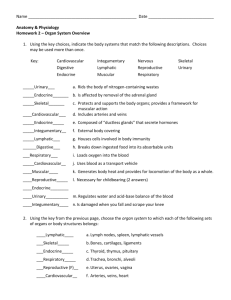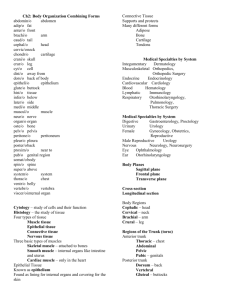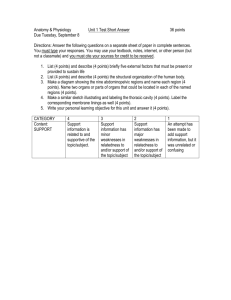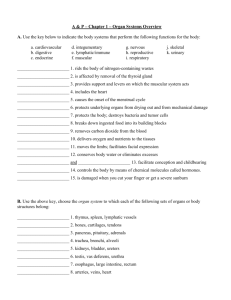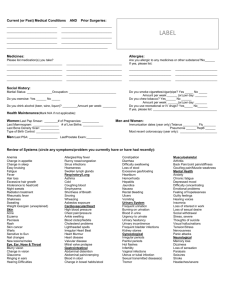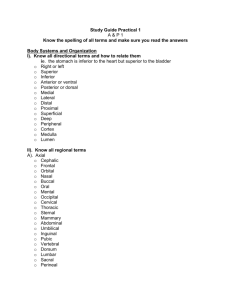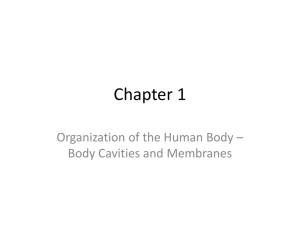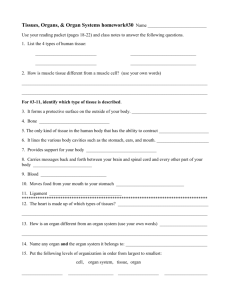Study Guide
advertisement
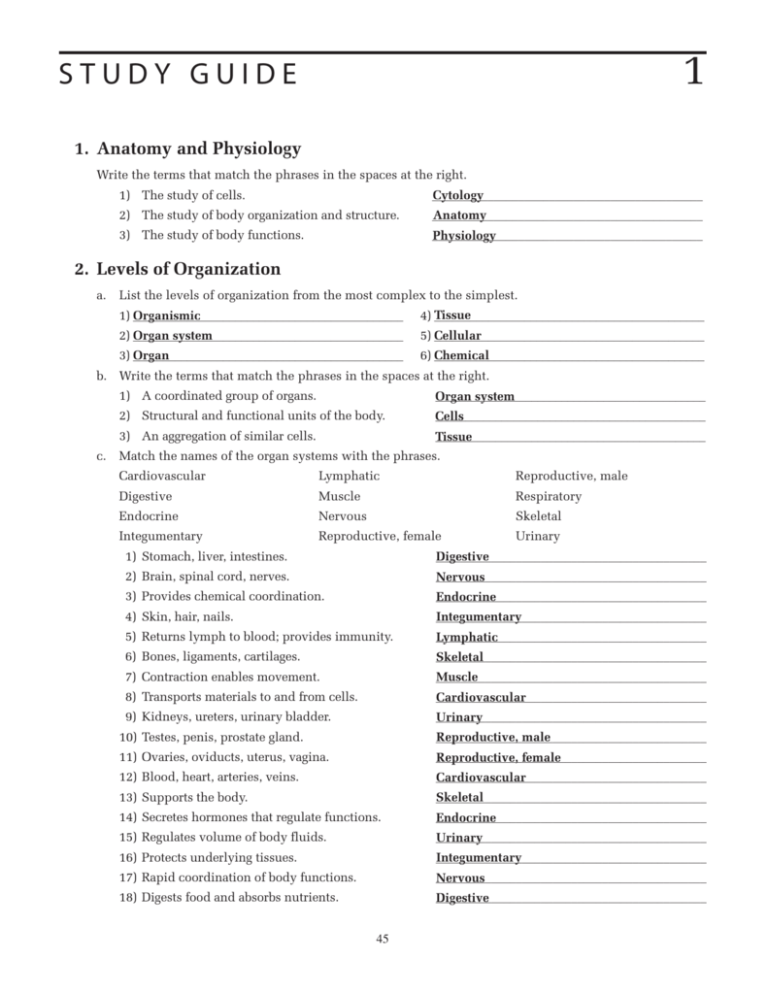
1 STUDY GUIDE 1. Anatomy and Physiology Write the terms that match the phrases in the spaces at the right. 1) The study of cells. ____________________________________________ Cytology 2) The study of body organization and structure. ____________________________________________ Anatomy 3) The study of body functions. ____________________________________________ Physiology 2. Levels of Organization a. List the levels of organization from the most complex to the simplest. 1) Organismic _____________________________________________ 4) Tissue _____________________________________________ system 2) Organ _____________________________________________ 5) Cellular _____________________________________________ 3) Organ _____________________________________________ 6) Chemical _____________________________________________ b. Write the terms that match the phrases in the spaces at the right. c. 1) A coordinated group of organs. _____________________________________________ Organ system 2) Structural and functional units of the body. _____________________________________________ Cells 3) An aggregation of similar cells. _____________________________________________ Tissue Match the names of the organ systems with the phrases. Cardiovascular Lymphatic Reproductive, male Digestive Muscle Respiratory Endocrine Nervous Skeletal Integumentary Reproductive, female Urinary 1) Stomach, liver, intestines. ____________________________________________ Digestive 2) Brain, spinal cord, nerves. ____________________________________________ Nervous 3) Provides chemical coordination. ____________________________________________ Endocrine 4) Skin, hair, nails. ____________________________________________ Integumentary 5) Returns lymph to blood; provides immunity. ____________________________________________ Lymphatic 6) Bones, ligaments, cartilages. ____________________________________________ Skeletal 7) Contraction enables movement. ____________________________________________ Muscle 8) Transports materials to and from cells. ____________________________________________ Cardiovascular 9) Kidneys, ureters, urinary bladder. ____________________________________________ Urinary 10) Testes, penis, prostate gland. ____________________________________________ Reproductive, male 11) Ovaries, oviducts, uterus, vagina. ____________________________________________ Reproductive, female 12) Blood, heart, arteries, veins. ____________________________________________ Cardiovascular 13) Supports the body. ____________________________________________ Skeletal 14) Secretes hormones that regulate functions. ____________________________________________ Endocrine 15) Regulates volume of body fluids. ____________________________________________ Urinary 16) Protects underlying tissues. ____________________________________________ Integumentary 17) Rapid coordination of body functions. ____________________________________________ Nervous 18) Digests food and absorbs nutrients. ____________________________________________ Digestive 45 19) Gas exchange between air and blood. ____________________________________________ Respiratory 20) Larynx, trachea, bronchi, and lungs. ____________________________________________ Respiratory 3. Directional Terms Provide the term that correctly completes each statement. 1) The head is _____ to the neck. ____________________________________________ Superior 2) The hand is _____ to the wrist. ____________________________________________ Distal 3) The skin is _____ to the muscles. ____________________________________________ Exterior (superficial) 4) The mouth is _____ to the nose. ____________________________________________ Inferior 5) The elbow is _____ to the wrist. ____________________________________________ Proximal 6) The ear is on the _____ surface of the head. ____________________________________________ Lateral 7) The umbilicus is on the _____ body surface. ____________________________________________ Anterior (ventral) 8) The hip is on the _____ body surface. ____________________________________________ Lateral 9) The buttocks are on the _____ body surface. ____________________________________________ Posterior (dorsal) 4. Body Regions Label the body regions by placing the number of the label line in the space by the correct label. 5 _____ Abdominal 7 _____ Abdominopelvic 20 Antebrachial _____ 4 _____ Antecubital 2 _____ Axillary 3 _____ Brachial 8 _____ Carpal 16 Cephalic _____ 1 _____ Cervical 21 Coxal _____ 14 Cranial _____ 12 Crural _____ 10 Digital _____ 15 Facial _____ 11 Genital _____ 19 Inguinal _____ 9 _____ Palmar 22 Patellar _____ 18 Pectoral _____ 23 Pedal _____ 6 _____ Pelvic 17 Sternal _____ 13 Tarsal _____ 2 _____ Brachial 4 _____ Cubital 11 Crural _____ 3 _____ Dorsum 9 _____ Femoral 7 _____ Gluteal 5 _____ Lumbar 12 Plantar _____ 8 _____ Perineal 10 Popliteal _____ 6 _____ Sacral 1 _____ Vertebral 5. Body Planes and Sections Name the planes that match the statements. 1) Divides the body into equal left and right halves. Midsagittal ____________________________________________ 2) Divides the body into superior and inferior portions. Transverse ____________________________________________ 3) Divides the body into left and right portions. Sagittal ____________________________________________ 4) Divides the body into anterior and posterior portions. Coronal (frontal) ____________________________________________ 47 6. Body Cavities a. Label the body cavities and related structures by placing the number of the label line in the space by the correct label. Cavities 2 _____ Abdominal 4 _____ Abdominopelvic 6 _____ Cranial 8 _____ Dorsal 3 _____ Pelvic 7 _____ Vertebral canal 1 _____ Thoracic 5 _____ Ventral Structure 9 Diaphragm _____ Cavities 4 Abdominal _____ 6 Abdominopelvic _____ 5 Pelvic _____ 2 Pericardial _____ 1 Pleural _____ 3 Thoracic _____ 7 Ventral _____ Structures 10 Diaphragm _____ 9 _____ Parietal pericardium 11 Parietal peritoneum _____ 8 _____ Parietal pleura 48 b. Place the number of the cavity in which the organ occurs in the space by the organ. c. 1) Abdominal 3) Pelvic 5) Thoracic, lateral parts 2) Cranial 4) Vertebral canal 6) Thoracic, mediastinum _____ 2 Brain 1 Kidneys _____ 4 Spinal cord _____ _____ 1 Gallbladder 1 Liver _____ 6 Thymus _____ _____ 6 Heart 5 Lungs _____ 3 Urinary bladder _____ _____ 1 Intestine, small 1 Pancreas _____ 3 Rectum _____ Write the names of the membranes that match the statements in the spaces at the right. 1) Covers the heart. ____________________________________________ Visceral pericardium 2) Covers the stomach. ____________________________________________ Visceral peritoneum 3) Lines the abdominal cavity. ____________________________________________ Parietal peritoneum 4) Covers the brain. ____________________________________________ Meninges 5) Lines the thoracic cavity. ____________________________________________ Parietal pleurae 6) Lines the spinal cavity. ____________________________________________ Meninges 7) Cover the lungs. ____________________________________________ Visceral pleurae 8) Forms double-membrane sac around heart. ____________________________________________ Parietal pericardium 9) Double-layered membranes supporting ____________________________________________ Mesenteries abdominal organs. 7. Abdominopelvic Subdivisions Select the abdominopelvic quadrant and abdominopelvic region in which the following structures are located. Quadrants Regions 1. Right upper 5. Epigastric 10. Right hypochondriac 2. Left upper 6. Hypogastric 11. Right iliac 3. Right lower 7. Left hypochondriac 12. Right lumbar 4. Left lower 8. Left iliac 13. Umbilical 9. Left lumbar 1, 2, 5, 7 Stomach _________ _____ 1, 5 Gallbladder _____ 2, 7 Spleen 1, 3, 10, 11, 12 Ascending colon ______________ 3, 4, 6 Urinary bladder ______ ______ 3, 4, 6 Rectum 2, 5, 13 Left kidney _______ _______ 1, 5, 13 Right kidney ______ 3, 6 Appendix 1,________ 2, 5, 13 Pancreas 8. Maintenance of Life Write the terms that match the statements in the spaces at the right. 1) Maintenance of a dynamic balance of substances ____________________________________________ Homeostasis in body fluids. 2) The sum of all life processes. ____________________________________________ Metabolism 3) Breakdown of complex substances. ____________________________________________ Catabolism 4) Synthesis of complex substances. ____________________________________________ Anabolism 5) Maintenance of a relatively stable internal Homeostasis ____________________________________________ environment. 49 6) Sum of the chemical reactions that occur in ____________________________________________ Metabolism the body. 7) List the five basic needs essential for human life. ____________________________________________ Food ____________________________________________ Water ____________________________________________ Oxygen ____________________________________________ Body temperature ____________________________________________ Atmospheric pressure 9. Clinical Applications a. A patient complains of pain in the epigastric region. What organs may be involved? _____________________________________________________________________________________________ Gall bladder, liver, pancreas, or stomach _____________________________________________________________________________________________ b. A patient complains of pain in the right lower quadrant. What organs may be involved? _____________________________________________________________________________________________ Appendix, cecum, ascending colon, or small intestine _____________________________________________________________________________________________ 50

